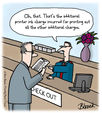Seeing the Big Picture
- Mo Lidsky
- Jul 25, 2017
- 2 min read

...excerpt from Mo Lidsky's latest book, Partners in Preservation
There is an old anecdote about several blind men in a room with an elephant. One man holds the elephant’s tail and thinks it is a snake. Another man touches the elephant’s leg and thinks it is a tree trunk. All the men hold one part of the elephant and think it is something else because they cannot put the big picture together.
The elephant problem is one of the most pervasive issues that face private investors. Every investment product that is sold to people has one aspect—a tail, a leg, or a trunk—that looks enticing. Maybe the investment has a high cash yield and you want current income. Maybe the investment has a great story behind it, such as the emerging middle class in a developing country. Or maybe it is just being sold to you by someone you like as a person. These factors may be important in isolation, but it is much more important to see the whole picture and analyze each investment opportunity in its entirety.
One classic and grave example of the elephant problem in recent history relates to mortgage-backed securities, the investments at the center of the financial crisis in 2008. Even sophisticated investors, such as pension plans, banks, and insurance companies, bought these securities by the armful. One of the main reasons for this rapacious purchasing was that one part of the whole picture was very compelling: these securities had the highest credit rating in the market but offered a better return than government bonds. What a bargain!
As Warren Buffett has often said, “When the tide goes out, that’s when you learn who’s been swimming naked.” In this case, the tide went out during the financial crisis and these investors, who focused on something in isolation instead of the big picture, were left exposed to permanent and devastating losses.
The financial crisis is an extreme example, but it shows how important it is to try to see the big picture. Responsible stewards of capital need to have the ability to piece together the big picture—by asking questions and working with others—and make decisions accordingly. To do this properly, investors must employ advisors or consultants who have the humility and expertise to ask the right questions and be capable of seeing the bigger picture.
The need for a larger perspective applies not only to specific investments but to the whole portfolio as well. Having different people advising on different segments of a portfolio without seeing the bigger picture is equivalent to having different architects working on different parts of your house. Just consider what your home might look like with all these experts pulling in their own directions; your portfolio would be no different.









Comments